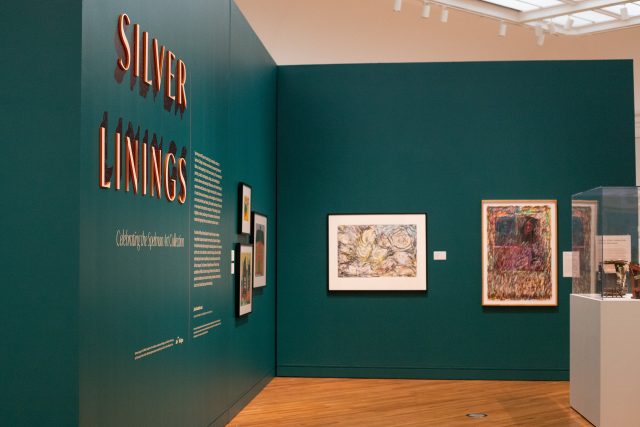[ad_1]
“Silver Linings,” a traveling exhibit of 40 works from the Spelman College Museum of Fine Art’s collection, debuted at the University of Michigan Museum of Art on Aug. 24. The exhibit, which will remain at UMMA through Jan. 5, celebrates Black art production and the commitment to collecting art by and about Black women at Spelman College, a historically Black women’s liberal arts college in Atlanta.
At UMMA, “Silver Linings” sorts the collection into different thematic categories throughout the exhibit. Ranging from “Abstraction and Blackness” to “Spirituality and Healing,” the exhibit seeks to highlight the diversity of the Black experience throughout the past century while challenging one-dimensional depictions of race. The collection includes a unique mix of Black art such as a bronze sculpture by Elizabeth Catlett and a quilt by Faith Ringgold.
“Silver Linings” was conceptualized by Anne Collins Smith, the former curator of collections at the Spelman College Museum of Fine Art. Liz Andrews, the executive director of the Spelman museum, said in an interview with The Michigan Daily that the show began as a collection of existing works on campus that were consolidated into a fully-formed exhibit.
“It started out as bringing together disparate works across campus that were in faculty offices or that a professor brought back from the African continent on a trip,” Andrews said. “But they really honed in on the idea of the Spelman museum as a place that celebrates art by and about Black women.”
To celebrate both the 25th anniversary of Spelman’s museum and its physical reopening after the COVID-19 pandemic, Andrews and Karen Comer Lowe, the curator-in-residence, formed “Silver Linings” to highlight the importance of art collection at historically Black colleges and universities. Andrews said HBCUs have been critical to the preservation of Black art through periods during which it was specifically neglected.
“The genesis (of this exhibit) really is much older than us,” Andrews said. “It’s really the fact that places like Spelman College as well as Fisk University, Howard University, Tuskegee, places where Black excellence has been nurtured, have also been places where (the work of) Black artists have been collected and exhibited at times when segregation was such that incredible artists were overlooked and actively excluded from major museums.”
While the show was exhibited at Spelman, Andrews connected with the Art Bridges Foundation to secure additional venues. Art Bridges, a nonprofit organization, increases public access to American art by providing financial and logistical support to smaller collections and institutions.
julia elizabeth neal, assistant professor of history of art and the guest curator of the “Silver Linings” display at UMMA, told The Daily that resisting the narrow depiction of African Americans extends into fields other than art as well.
“The project of reflecting the multiplicity of Blackness isn’t something that is a one-off gesture,” neal said. “In fact, this is an always-emerging conversation that resists monolithic understandings of one’s racialized experience that’s attached with either their body being racialized as a Black body, or cultural and ethnic proximity to the United States and African American communities, as well as the broader Black Diaspora.”
In an email to The Daily, Art & Design sophomore Desi Hudson wrote that they believe art can help to expose and celebrate individualism within the Black community.
”I’ve always found it weird how across the African Diaspora, specifically the African American Diaspora, that we have so many shared experiences while living different, unique lives,” Hudson wrote. “It is with art that I wish for these gaps in our knowledge of each other to be filled.”
Andrews, who will see the installation for the first time while visiting for the “Deep Roots, Bright Futures” public discussion on “Silver Linings” on Sept. 27, said she looked forward to experiencing UMMA’s unique adaptation of the exhibit.
“Part of the beauty of sending an exhibition on the road is seeing the ways that another set of eyes could reinterpret the intellectual labor that you’ve done to create this body of work that’s in conversation with itself,” Andrews said.
Hudson wrote that they hope the U-M campus, of which Black students make up only 5% of the undergraduate population, will be exposed to new ideas around art and culture through the exhibit.
”As an Atlanta native and U-M student, finding out that this collection is coming to my school came as a shock, but in a good way,” Hudson wrote. “I want the Ann Arbor community and students of a (predominantly white institution) to take time to deconstruct the Western (and) Euro-centric ideas of what art should be through these works.”
Angel Ware, a sophomore at Spelman College, wrote in an email to The Daily that they believe “Silver Linings” presence at the University of Michigan will emphasize the importance of Black women and their art after a long history of discrimination and neglect.
“Historically, academic spaces have been less accessible to Black women, leaving a gap in their perspectives and lived experiences in academia,” Ware wrote. “Although that gap is decreasing, for decades Black women have had to utilize art … to express their lived experiences. Preserving the art of Black women not only signifies that the perspectives and stories are valuable, but can teach us something about society and maybe even ourselves.”
Daily Staff Reporter Marissa Corsi can be reached at macorsi@umich.edu.
Related articles
[ad_2]
Source link











